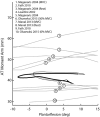Variation in the human Achilles tendon moment arm during walking
- PMID: 27460018
- PMCID: PMC5578703
- DOI: 10.1080/10255842.2016.1213818
Variation in the human Achilles tendon moment arm during walking
Abstract
The Achilles tendon (AT) moment arm is an important determinant of ankle moment and power generation during locomotion. Load and depth-dependent variations in the AT moment arm are generally not considered, but may be relevant given the complex triceps surae architecture. We coupled motion analysis and ultrasound imaging to characterize AT moment arms during walking in 10 subjects. Muscle loading during push-off amplified the AT moment arm by 10% relative to heel strike. AT moment arms also varied by 14% over the tendon thickness. In walking, AT moment arms are not strictly dependent on kinematics, but exhibit important load and spatial dependencies.
Keywords: Gait; musculoskeletal model; plantarflexors; triceps surae; ultrasound.
Figures



Similar articles
-
Aging effects on the Achilles tendon moment arm during walking.J Biomech. 2018 Aug 22;77:34-39. doi: 10.1016/j.jbiomech.2018.06.001. Epub 2018 Jun 18. J Biomech. 2018. PMID: 29945784 Free PMC article.
-
Correlations between Achilles tendon moment arm and plantarflexor muscle architecture variables.PLoS One. 2024 Aug 29;19(8):e0309406. doi: 10.1371/journal.pone.0309406. eCollection 2024. PLoS One. 2024. PMID: 39208198 Free PMC article.
-
Estimates of Achilles tendon moment arm differ when axis of ankle rotation is derived from ankle motion.J Biomech. 2019 Jun 11;90:71-77. doi: 10.1016/j.jbiomech.2019.04.032. Epub 2019 Apr 29. J Biomech. 2019. PMID: 31084886
-
Imaging and simulation of Achilles tendon dynamics: Implications for walking performance in the elderly.J Biomech. 2016 Jun 14;49(9):1403-1410. doi: 10.1016/j.jbiomech.2016.04.032. Epub 2016 May 3. J Biomech. 2016. PMID: 27209552 Free PMC article. Review.
-
Imaging-based estimates of moment arm length in intact human muscle-tendons.Eur J Appl Physiol. 2004 Mar;91(2-3):130-9. doi: 10.1007/s00421-003-1033-x. Epub 2003 Dec 18. Eur J Appl Physiol. 2004. PMID: 14685871 Review.
Cited by
-
How do differences in Achilles' tendon moment arm lengths affect muscle-tendon dynamics and energy cost during running?Front Sports Act Living. 2023 Apr 17;5:1125095. doi: 10.3389/fspor.2023.1125095. eCollection 2023. Front Sports Act Living. 2023. PMID: 37139299 Free PMC article.
-
Beyond Inverse Dynamics: Methods for Assessment of Individual Muscle Function during Gait.Bioengineering (Basel). 2024 Sep 6;11(9):896. doi: 10.3390/bioengineering11090896. Bioengineering (Basel). 2024. PMID: 39329638 Free PMC article. Review.
-
Normative Achilles and patellar tendon shear wave speeds and loading patterns during walking in typically developing children.Gait Posture. 2021 Jul;88:185-191. doi: 10.1016/j.gaitpost.2021.05.023. Epub 2021 May 27. Gait Posture. 2021. PMID: 34098404 Free PMC article.
-
Achilles tendon compliance influences tendon loading more than Achilles tendon twist in Achilles tendinopathy: a musculoskeletal modeling approach.Front Bioeng Biotechnol. 2024 Jul 18;12:1399611. doi: 10.3389/fbioe.2024.1399611. eCollection 2024. Front Bioeng Biotechnol. 2024. PMID: 39091972 Free PMC article.
-
Achilles Tendon Ruptures and Repair in Athletes-a Review of Sports-Related Achilles Injuries and Return to Play.Curr Rev Musculoskelet Med. 2022 Oct;15(5):353-361. doi: 10.1007/s12178-022-09774-3. Epub 2022 Jul 9. Curr Rev Musculoskelet Med. 2022. PMID: 35804260 Free PMC article. Review.
References
-
- Bojsen-Møller J, Magnusson SP. Heterogeneous Loading of the Human Achilles Tendon In Vivo. Exerc Sport Sci Rev. 2015 Oct;43:190–7. - PubMed
-
- Cram JR, Kasman GAS. Introduction to surface electromyography. Gaithersburg: Aspen Publishers; 1998.
-
- Fath F, Blazevich AJ, Waugh CM, Miller SC, Korff T. Direct comparison of in vivo Achilles tendon moment arms obtained from ultrasound and MR scans. J Appl Physiol (1985) 2010 Dec;109:1644–52. - PubMed
-
- Fath F, Blazevich AJ, Waugh CM, Miller SC, Korff T. Interactive effects of joint angle, contraction state and method on estimates of achilles tendon moment arms. J Appl Biomech. 2013 Apr;29:241–4. - PubMed
MeSH terms
Grants and funding
LinkOut - more resources
Full Text Sources
Other Literature Sources
Medical
